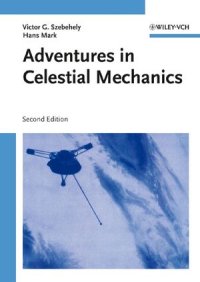
Ebook: Adventures in Celestial Mechanics
A fascinating introduction to the basic principles of orbital mechanics
It has been three hundred years since Isaac Newton first formulated laws to explain the orbits of the Moon and the planets of our solar system. In so doing he laid the groundwork for modern science's understanding of the workings of the cosmos and helped pave the way to the age of space exploration.
Adventures in Celestial Mechanics offers students an enjoyable way to become acquainted with the basic principles involved in the motions of natural and human-made bodies in space. Packed with examples in which these principles are applied to everything from a falling stone to the Sun, from space probes to galaxies, this updated and revised Second Edition is an ideal introduction to celestial mechanics for students of astronomy, physics, and aerospace engineering. Other features that helped make the first edition of this book the text of choice in colleges and universities across North America include:
* Lively historical accounts of important discoveries in celestial mechanics and the men and women who made them
* Superb illustrations, photographs, charts, and tables
* Helpful chapter-end examples and problem setsContent:
Chapter 1 On the Shoulders of Giants: An Historical Review (pages 1–12):
Chapter 2 Circular Orbits (pages 13–31):
Chapter 3 The General Problem of two Bodies (pages 33–46):
Chapter 4 Elliptic Orbits (pages 47–63):
Chapter 5 Rockets (pages 65–84):
Chapter 6 Energy Relationships: Hyperbolic and Parabolic Orbits (pages 85–97):
Chapter 7 Kepler's Equation and Lambert's Theorem (pages 99–138):
Chapter 8 Orbital Maneuvering of Spacecraft (pages 139–160):
Chapter 9 Elements of Spacecraft Dynamics (pages 161–185):
Chapter 10 Planetary Exploration (pages 187–220):
Chapter 11 General Perturbation Theory and a Specific Application to the Motion of the Planet Mercury (pages 221–245):
Chapter 12 The Motion of Earth?Orbiting Satellites (pages 247–262):
Chapter 13 The Problem of Three Bodies and the Stability of the Solar System (pages 263–282):
It has been three hundred years since Isaac Newton first formulated laws to explain the orbits of the Moon and the planets of our solar system. In so doing he laid the groundwork for modern science's understanding of the workings of the cosmos and helped pave the way to the age of space exploration.
Adventures in Celestial Mechanics offers students an enjoyable way to become acquainted with the basic principles involved in the motions of natural and human-made bodies in space. Packed with examples in which these principles are applied to everything from a falling stone to the Sun, from space probes to galaxies, this updated and revised Second Edition is an ideal introduction to celestial mechanics for students of astronomy, physics, and aerospace engineering. Other features that helped make the first edition of this book the text of choice in colleges and universities across North America include:
* Lively historical accounts of important discoveries in celestial mechanics and the men and women who made them
* Superb illustrations, photographs, charts, and tables
* Helpful chapter-end examples and problem setsContent:
Chapter 1 On the Shoulders of Giants: An Historical Review (pages 1–12):
Chapter 2 Circular Orbits (pages 13–31):
Chapter 3 The General Problem of two Bodies (pages 33–46):
Chapter 4 Elliptic Orbits (pages 47–63):
Chapter 5 Rockets (pages 65–84):
Chapter 6 Energy Relationships: Hyperbolic and Parabolic Orbits (pages 85–97):
Chapter 7 Kepler's Equation and Lambert's Theorem (pages 99–138):
Chapter 8 Orbital Maneuvering of Spacecraft (pages 139–160):
Chapter 9 Elements of Spacecraft Dynamics (pages 161–185):
Chapter 10 Planetary Exploration (pages 187–220):
Chapter 11 General Perturbation Theory and a Specific Application to the Motion of the Planet Mercury (pages 221–245):
Chapter 12 The Motion of Earth?Orbiting Satellites (pages 247–262):
Chapter 13 The Problem of Three Bodies and the Stability of the Solar System (pages 263–282):
Download the book Adventures in Celestial Mechanics for free or read online
Continue reading on any device:

Last viewed books
Related books
{related-news}
Comments (0)